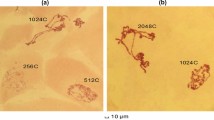Summary
The crossDrosophila insularis ×Drosophila tropicalis produces viable but completely sterile hybrids. Chromosomes have been studied in the cells of the salivary glands in hybrid larvae. The euchromatic sections of the chromosomes of the two species remain completely unpaired in the hybrid, despite the obvious similarities of the disc patterns in many portions of these chromosomes. A common chromocenter is nevertheless formed, owing to a mutual attraction of the heterochromatic sections adjacent to the centromeres in all the chromosomes. The condition of the chromosomes in the female and male cells is represented schematically in Fig. 1. The X-chromosomes show a remarkable difference in behavior in the cells of the two sexes. The euchromatic strands representing the X-chromosome are appreciably greater in width but somewhat paler in staining in male than in female larvae. This is a visible counterpart of the genetic phenomenon of dosage compensation.
Similar content being viewed by others
Bibliography
Aronson, J. P., G. T. Rudkin andJ. Schultz: A comparison of giant X-chromosomes in male and femaleDrosophila melanogaster by cytophotometry in the ultraviolet. J. Histochem. a. Cytochem.2, 458–459 (1954).
Beermann, W.: Chromomerenkonstanz und spezifische Modifikationen der Chrompsomenstruktur in der Entwicklung und Organdifferenzierung vonChironomus tentans. Chromosoma5, 139–198 (1952).
Breuer, M., andC. Pavan: Behavior of polytene chromosomes ofRhynchosciara angelae at different stages of larval development. Chromosoma7, 321–386 (1955).
Burla, H., A. B. da Cunha, A. R. Cordeiro, Th. Dobzhansky, C. Malogolowkin andC. Pavan: Thewillistoni group of sibling species ofDrosophila. Evolution3, 300–314 (1949).
Dobzhausky, Th.: The chromosomes ofDrosophila willistoni. J. Hered.41, 156–158 (1950).
-Genetics of natural populations. XXVI. Chromosomal variability in island and continental populations ofDrosophila willistoni from Central America and the West Indies. Evolution 1957 (in press).
Mechelke, F.: Reversible Strukturmodifikationen der Speicheldrüsenchromosomen vonAcricotopus lucidus. Chromosoma5, 511–543 (1952).
Muller, H. J.: Evidence of the precision of genetic adaptation. Harvey Lect.43, 165–229 (1950).
Pavan, C., andM. Breuer: Polytene chromosomes in different tissues ofRhynchosciara. J. Hered.43, 150–157 (1952).
Sturtevant, A. H., andTh. Dobzhansky: Geographical distribution and cytology of “sex-ratio” inDrosophila pseudoobscura and related species. Genetics21, 473–490 (1936).
Author information
Authors and Affiliations
Additional information
The work reported in this article has been supported in part under Contract No. AT-(30-1)-1151, U. S. Atomic Energy Commission
Rights and permissions
About this article
Cite this article
Dobzhansky, T. The X-chromosome in the larval salivary glands of hybrids Drosophila insularis × Drosophila tropicalis. Chromosoma 8, 691–698 (1956). https://doi.org/10.1007/BF01259527
Received:
Issue Date:
DOI: https://doi.org/10.1007/BF01259527




